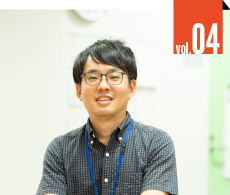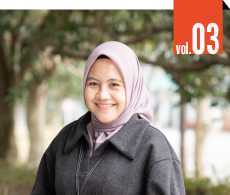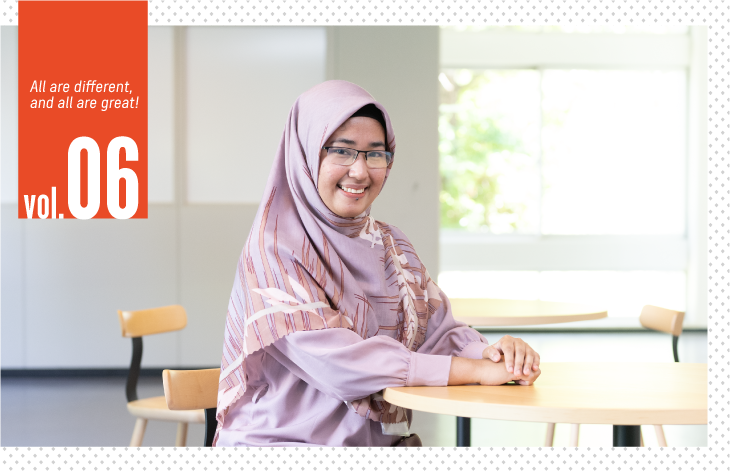
![]()
Juharni
Materials Science
Laboratory of Solid-State Information Physics
Grade:2nd year, PhD student
Birthplace: Indonesia, South-Sulawesi
Undergraduate research: The application of magnetic material
Graduate school research: Ferromagnetic material in three-dimensional shape
How did you join NAIST and what is your current research?
Prior to joining NAIST, my interest in the field of magnetism has been steadfast since my undergraduate years and continues to this day. Upon completing my undergraduate program at Universitas Islam Negeri (UIN) Alauddin Makassar in the Physics Science Department, I pursued a master's degree at Universitas Gadjah Mada (UGM) in Yogyakarta, Indonesia, specializing in Physics Science. During my tenure at UGM, I got married and became a mother. In my second year at UGM, I had the opportunity to participate in NAIST's pre-screening program in December 2019, a two-week endeavor. My family, including my husband and my relatives, took care of my then 2-year-old son during my visit to Japan for this program.
The pre-screening program was a collaborative effort between NAIST and UGM, tailored for students aspiring to enroll in NAIST's doctoral program through a preliminary internship. Conducted annually, the program offered successful candidates a two-week stint at NAIST, allowing them to experience laboratory dynamics and determine their fit within NAIST's doctoral program. This served as a golden opportunity for me to quickly identify a suitable laboratory for my research topic. The program permitted us to explore various laboratories aligned with our interests and aspirations, facilitating direct interaction with professors spearheading research in our respective areas of interest. It was during this period that I discovered the Solid State Information Physics Laboratory, the sole facility dedicated to magnetic materials. Engaging directly with Professor Hattori, I discussed the alignment of my research with magnetism, gaining valuable insights and knowledge in the process. Additionally, the availability of advanced magnetic measurement equipment solidified my decision to choose NAIST for my doctoral pursuit.
Another compelling reason for selecting NAIST was the institution's inclusivity and consideration for Muslim students. Facilities for prayers are thoughtfully provided, and I found this aspect accommodating to my religious practices. This reassurance relieved concerns about fulfilling my religious obligations and bolstered my commitment to higher education.
Furthermore, as a mother, I received substantial support from my supervisor. Valuable advice regarding childcare centers was extended, exemplifying the institution's commitment to assisting students in balancing their academic and personal responsibilities.
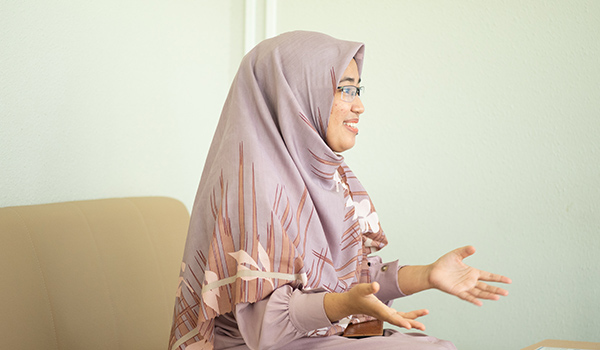
Research life and career development of women
At NAIST, my current research focuses on ferromagnetic films in three-dimensional (3D) structures. This experimental study encompasses sample fabrication and subsequent property analysis through various measurements, including the examination of magnetic properties using a Vibration Sample Magnetometer (VSM). The research delves into the intricate realm of three-dimensional magnetism, unraveling captivating phenomena within the realm of materials and physics. One particularly captivating concept stemming from this exploration is the "magnetic vortex" holding immense promise within the domains of magnetic memory and information technology. The ability to control the motion of vortex in 3D structures has potential applications in magnetic memory devices and magnetic logic circuits. Overall, the rising vortex behavior from 3D structures is a dynamic and intriguing phenomenon in the field of magnetism. It showcases the complex interplay between magnetic interactions, external influences, and material properties. Studying and harnessing this behavior has the potential to contribute to the development of advanced magnetic technologies.
Generally, my work in the doctoral program revolves around designing and conducting experiments, analyzing intricate data sets, and refining my research methodologies to address the complexities of my chosen research topic. Briefly, my daily activities are as follows.
I come to laboratory at 9 or 10 am, at the time my son also goes to children's preschool from 9:00am-3:00pm by bus that takes him to and from the dormitory, which is very helpful.
At Takayama Kodomoen, where my son attends, there are currently four children whose parents are NAIST students from Indonesia. About a month ago, the preschool organized an event to introduce Indonesian culture to the children and their teachers. Takayama Kodomoen is the only childcare facility in Ikoma City that serves halal food for school lunches. This is one of the main reasons why parents from Indonesia and Muslims choose Takayama Kodomoen.
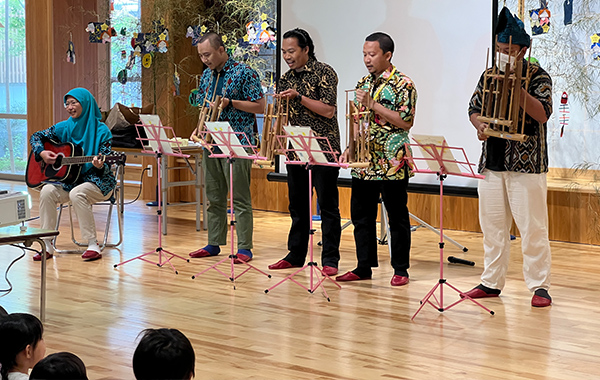
After I finish my work in the laboratory, I go back home around 6 or 7.30 pm, depending on my work. As a mother, I always try to finish my work at the laboratory, because at home I spare my time for family. Being a mother and doctoral student, I must have good time- and emotional management skills, multitasking abilities, and adaptability, because I must be a professional and do my duty as a student in NAIST.
In Indonesia, there are many women with children who do not have jobs. In my opinion, this is caused by less time management, motivation, or lack of support from their husband and family. But in my case, I am grateful because my husband and family fully support me to continue my study. I believe that every woman has talent and potential, but devoting time, support, and effort to taking care of children can limit their talent and potential.
Another motivation that makes me want to continue my studies comes from my mother. Since my father died when I was 7 years old, my mother has worked a lot to raise me. My mother encouraged me to be more knowledgeable and independent, saying that women need skills even if they have children, and I began to think the same way as my mother, having watched her all in my life as my role model. I really want to thank her for her praying for and motivating me.
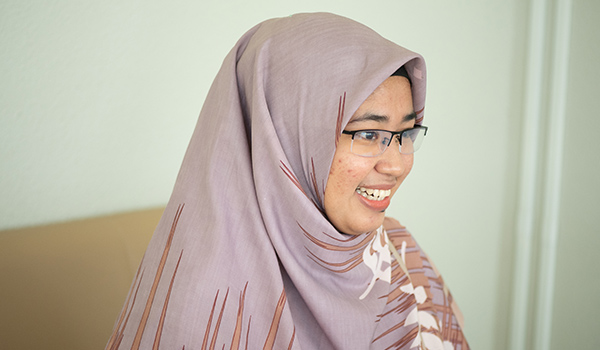
Related to research environment
I have truly relished my academic journey here, primarily due to the focused nature of our research topics. However, the real challenge lies in effectively completing our studies and generating substantial research outcomes within the span of three years. Within the research context, the most prominent hurdles pertain to linguistic and cultural adaptation. Concerning language, the professors seamlessly switch between Japanese and English, ensuring smooth communication. Nevertheless, instances arise when communication with Japanese students, who have limited proficiency in English, presents minor obstacles. To overcome this, we resort to utilizing translation assistance.
Furthermore, for international researchers, acclimatizing to an unfamiliar cultural and social milieu can be both invigorating and demanding. Navigating local traditions and social norms necessitates an investment of time. Additionally, the flux of seasonal changes can occasionally impede our physical well-being, consequently affecting our daily laboratory routines. In Indonesia, we are accustomed to just two distinct seasons—dry and rainy. Contrarily, Japan experiences four seasons, and upon my initial arrival, I found it challenging to adapt to the oscillations between extreme hot and cold. Coping with allergies triggered by hay fever, particularly pronounced during spring, has been eased by medications from the Health Service Center at NAIST. Whenever illness or injury strikes, laboratory peers accompany me to the hospital and facilitate communication with medical staff. The lab environment closely resembles a supportive family unit, devoid of any discrimination based on ethnicity or religion.
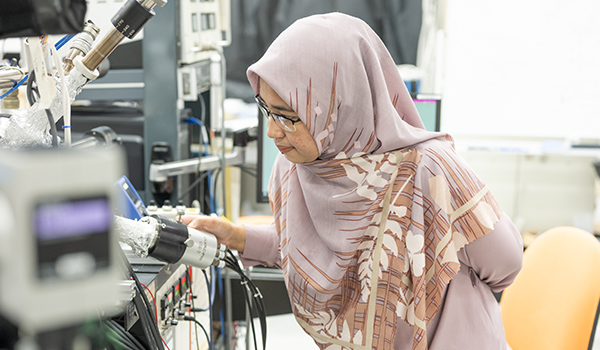
(August 2023)








